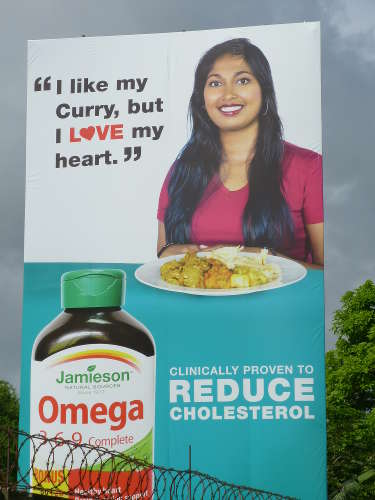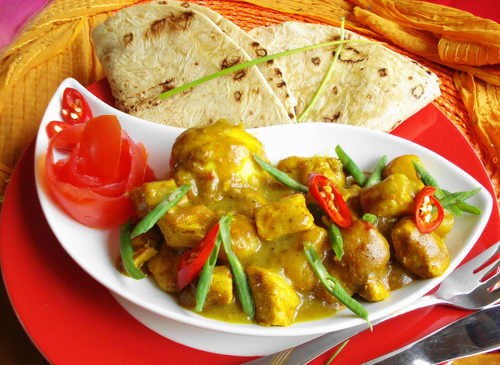“The public should be warned that the claim about the unhealthy effects of curry in this [Omega 3-6-9 Complex] advertisement is false, unscientific and misleading. The advertisement should be immediately removed with an apology made to all curry consumers and educated people.”
The following Letter to the Editor on a Jamieson Omega 3-6-9 Complex advertisement hinting at the negative effects of curry was submitted to Wired868 by Dr Kumar Mahabir:

The Omega 3-6-9 Complex advertisement on the nation’s highways—and now on television—is an out-of-place, outright attack on all curry consumers. Indeed, it is an ethnic form of aggression on a group of people in multi-culinary Trinidad and Tobago.
This billboard advertisement suddenly appeared at various points on the highways with the tagline: “I like my Curry, but I love my heart.” The product being advertised is the Jamieson’s brand of Omega 3-6-9 Complex. The caption is followed by additional texts claiming that the tablets have been “Clinically proven to REDUCE Cholesterol.”
The caption is accompanied by an Indian woman with two tresses of long, flowing, black hair. She is serving a plate of paratha “buss-up-shut” roti with pumpkin, curried channa and aloo, curried chataigne [breadnut] and curried mango.
The public should be warned that the claim about the unhealthy effects of curry in this advertisement is false, unscientific and misleading. The advertisement should be immediately removed with an apology made to all curry consumers and educated people.
Curry powder is made from a blend of natural spices such as coriander, turmeric (“saffron”), ginger, cumin, fenugreek, nutmeg, fennel, cloves, tamarind, cinnamon, cardamom, chili peppers and curry leaves. On the other hand, Omega 3-6-9 is made from chemicals manufactured from fatty acids and fish oil and coated with gelatin sourced from beef and sometimes pork.

(Courtesy Caribbean Pot)
Gelatin is generally a faintly yellow, nearly transparent, glutinous substance obtained by boiling the skin, bones and ligaments of animals to form a glue. Vegetarians, Hindus and Muslims, therefore, should not be consuming Omega 3-6-9.
Contrary to the claims of the Omega advertisement, consuming curried foods have been clinically proven to lower the levels of “bad” cholesterol (LDL), thereby reducing the risk of coronary heart disease (CHD) and strokes.
A review of the potential medicinal benefits of murraya koenigii (curry leaves) in dyslipidemia was done by Mamta Parnami and Dr Kanika Varma of the University of Rajasthan in India. Their review was published in the International Journal of Advanced Scientific Research and Management (2018).
Dyslipidemia is defined as an elevation of the total cholesterol, the “bad” low-density lipoprotein (LDL) cholesterol and the triglyceride concentrations, and a decrease in the “good” high-density lipoprotein (HDL) cholesterol concentration in the blood. Dyslipidemia is an important risk factor for coronary heart disease (CHD) and stroke.
The researchers from the University of Rajasthan reviewed studies on the medicinal benefits of curry leaves on human experimental models. In one study, 38 persons were given a preparation of fine ground curry leaves twice daily, at a dose of 3 grams per meal for a period of 5 weeks. The study revealed a significant decline in total cholesterol (P=0.03).

Parnami and Varma also reviewed another study in which 40 post-menopausal women 45-65 years of age, with hyperlipidemia, were given with dried curry leaf powder (5gms) added to their main side dish during lunch for 45 consecutive days.
At the end of the experimental period, there was a decrease of about 31.4 mg/dl TC, 15.9mg/dl TG, 23.8 mg/dl of the “bad” low-density lipoprotein (LDL) cholesterol. It was also observed that there was an increase of 6.5 mg/dl in the “good” high-density lipoprotein (HDL) cholesterol concentration in the blood.
Want to share your thoughts with Wired868? Email us at editor@wired868.com.
Please keep your letter between 300 to 600 words and be sure to read it over first for typos and punctuation.
We don’t publish anonymously unless there is a good reason, such as an obvious threat of harassment or job loss.
 Wired868 Wired868 for smart sport news and opinion
Wired868 Wired868 for smart sport news and opinion







I remember passing the billboard. Lol. It was enough to get me to raise one eyebrow. I can’t say what crossed my mind then but it’s less important now. The source of food additives on the whole will always be a concern for one minority segment of society or the other. It really depends on prevailing food safety and health research, customs or religious beliefs. But these are million or billion dollar industries we’re talking about. Mass production is not tailored for minorities. Only advertising strategies. Well sometimes anyway. It’s more expensive and therefore infringes on the bottom line to cater for segments with special consumption needs. A little research and some critical thought will also tell you that there is more to lose by specifying e.g. beef vs pork sources. At the end of the day, as an individual, I understand my religious beliefs and why and what I choose to consume really depends on what I understand and choose to apply.
Study after study iin North America and the UK have found that the average dhalpourie wrap with no more than 2 ingredient fillings i.e. meat and veg, or meat and meat, or veg and veg had higher sodium content than any other similarly priced option. From the point of view of calories it may be favourable to a burger and fries option but the sodium conten, no matter the restaurant or the ingredients would be higher in the roti. A saag Paneer was especially off the sodium charts. The food industries trending scapegoat is sodium at the moment so curried dishes are recommended to be eaten in moderation.
Relax Dr. Mahabir my brother you would probably find that curry consumption goes up just as consumption of Saag Paneer at my favourite spot in Toronto did. corporatism being what it is that billboard was probably purposely neant to get an onlooker craving a buss up shut meal and guilt them into buying useless pills after. Guarantee somebody gets paid on both ends.
Does increased sodium intake lead to high cholesterol? The ad is for cholesterol reduction.
Curry was likely a poor choice of words. I think the benefits of curry as stated by the author is well known.
I’m guessing that the high cholesterol “culprits” might not be the curry but the foods that are curried or the cooking process. I don’t know if curry chicken is any higher in cholesterol than stew chicken. Perhaps it’s the paratha. I never cooked paratha so I don’t know how much unhealthy oil is involved if at all.
This request might itself be offensive – what about the so-called uneducated people following this statement, “The public should be warned that the claim about the unhealthy effects of curry in this [Omega 3-6-9 Complex] advertisement is false, unscientific and misleading. The advertisement should be immediately removed with an apology made to all curry consumers and educated people.”